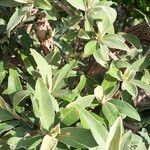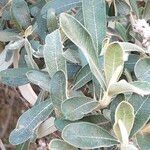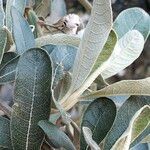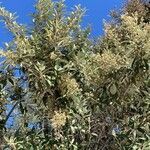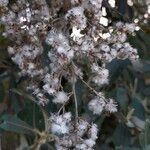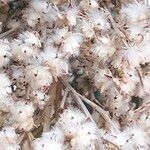Shrub or small tree to 9 m tall, usually much-branched; trunk diameter to 40 cm; bark brown or grey, rough, longitudinally fissured, exfoliating in long strips; young stems densely clothed in white felt-like tomentum.. Leaves shortly petiolate; petiole 0.2–1 cm long; blade narrowly to broadly elliptic or oblanceolate, 2–13.5 cm long, 0.4–4.5 cm wide, base cuneate or attenuate, margins entire, apex obtuse or subacute and shortly mucronate, discolorous, green and glabrous except for mid-rib above, felted with dense white or grey tomentum beneath, prominently pinnately veined, strongly camphor-scented when crushed; on coppice shoots may be larger and more tomentose above.. Capitula small, numerous in usually copious terminal compound open paniculoid thyrses, leafy in lower part with smaller bracts in upper part and yellow-brown tomentose when young, shortly pedicellate; involucres campanulate, 2.5–6 mm long; phyllaries ± 5, 2–6 mm long, tomentose beneath, glabrous above, in male capitula connate in lower 1/2–1/4, in female capitula free.. Male florets 12–66; corolla white, tube infundibuliform, 1.8–3.5 mm long with long white hairs, lobes ovate, 0.5–1.3 mm long, styles white, the upper part long-exserted; female florets 1–6; corolla almost glabrous to densely hairy, 4–5-lobed, 0.8–1.2 mm long, lobes ovate, 0.5–0.8 mm long.. Achenes obovoid in outline, narrowed towards the base and apex, brown, 1.6–4 mm long, 3-ribbed on one face, 1-ribbed on the other, densely covered in long white cotton-woolly hairs and crowned with persistent corolla.. Fig. 2.
Shrub or small tree, up to 8 m high; aromatic, male and female florets on separate plants. Leaves: alternate; blade narrowly elliptic to slightly narrowly obovate, up to 80 x 20 mm, apex acute, often mucronate, sometimes obtuse, base cuneate, margins entire, upper surface grey-green or khaki-green, reticulate, glabrous, lower surface densely grey-or greenish hairy, main and secondary veins prominent; petiole up to 5 mm long. Heads discoid, sessile or shortly pedunculate, in lax, open, terminal panicles. Involucral bracts of male plants uniseriate, fused halfway; of female plants 2-or 3-seriate, free, imbricate. Flowers: disc florets only, creamy white; (Feb.)May-Aug. (for FS not recorded in Feb.) Fruit with cypsela of female plants elliptic, ribbed, densely long, creamy or yellowish hairy. Pappus absent.
Leaves subsessile or with a petiole up to c. 6 mm. long and tomentellous; lamina very variable in size c. 2 x 0.5 to c. 8.5(12) x 3.5(5) cm., narrowly oblong-elliptic, elliptic or oblanceolate to narrowly obovate, apex subacute obtuse or rounded, base cuneate, margins entire; upper surface glabrescent, finely tessellate-reticulate with numerous golden glandular-globules along deeply depressed veins; under surface white-felted, the tomentum ± obscuring minute golden glands, midrib and nerves prominent beneath.
Female capitula; involucres 3–3.5 x 6 mm., broadly turbinate to subglobose; phyllaries 2–3-seriate, imbricate, rotund to narrowly ovate, shortly connate at base or free, tomentose-araneose outside and often long ciliate about the upper margins; florets 4–5, corollas c. 1 mm. long, shortly funnel-shaped, lanate outside, stigma shortly bifid exserted; achene c. 2.5–3(4) x 1.5 mm., somewhat compressed ellipsoid, densely covered in a mass of long sericeous-woolly hairs.
Male capitula; involucres 2.5–3.5 x 3.5–5 mm., broadly turbinate to shallowly cupuliform, phyllaries 5–6, ovate, connate below, sometimes also with several free shorter narrowly oblong-ovate phyllaries, tomentose-araneose outside; florets (3)10–25, corollas c. 2.5 mm. long broadly funnel-shaped, densely woolly outside, anther thecae 1.5–2 mm. long, exserted, style linear exserted by c. 1.5 mm. above the anther tube, ovary rudimentary.
A dense shrub or small tree. It grows 8 m tall. The trunk is 40 cm across. The bark is grey and cracked. The twigs have a felted covering. The leaf blade varies in size. It can be 2-8 cm long by 1-4 cm wide. It is narrowly oval. There is a white covering under the leaves. Male and female flowers are on separate plants. There are many flower heads in groups at the ends of branches.
Shrub or small tree, up to 8 m high. Twigs leafy throughout. Leaves: upper surface smooth or pitted, glandular, margins subentire, lamina up to 70 mm long, petiole 1-3(-5) mm long. Female heads ± 3-flowered. Flowers cream-white.
Trunk up to c. 40 cm. in diam., bark greyish, fissured; twigs leafy, closely greyish-or pale brown-felted.
Dense shrubs or small trees up to c. 8 m. tall, with a strong camphor odour.
Heads numerous in large leafy terminal panicles.
